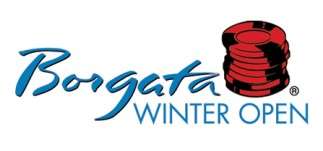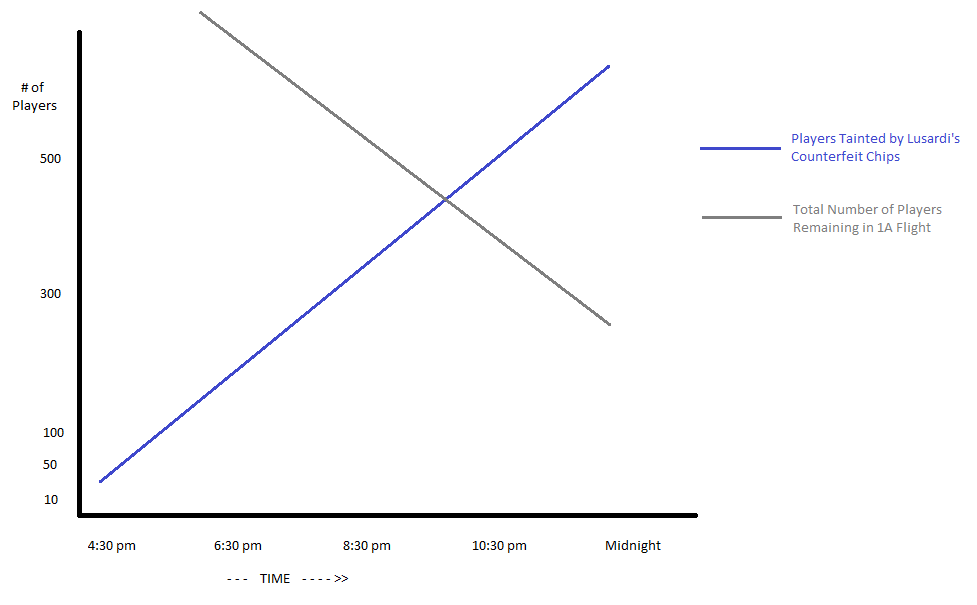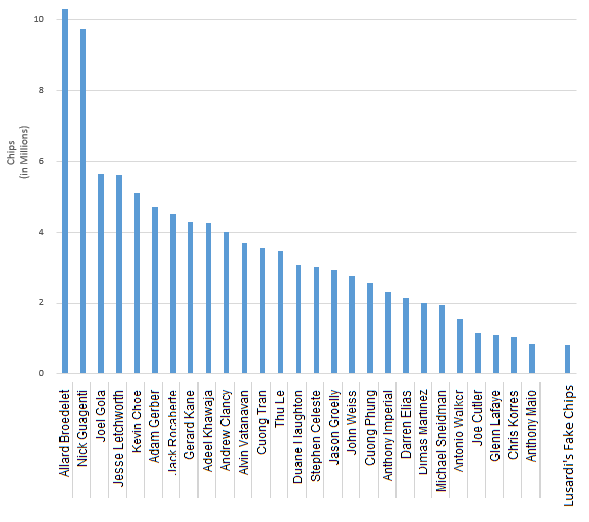Why the Borgata Counterfeit Chip Ruling is Unfair
This week’s release by the New Jersey Department of Gaming Enforcement (DGE) regarding the resolution of outstanding prize payouts for the cancelled opening event of January’s 2014 Borgata Winter Poker Open continues to create a firestorm of controversy regarding the manner in which remaining prize monies and tournament-expense fees were redistributed to players.
In that statement, published by the DGE here, and accompanied by a longer press release issued by the Borgata here, a total of $1,721,805 will be distributed. That includes the $1,433,145 in prize money that had yet to be awarded when play was stopped on January 17th, along with an additional $288,720 in tourney-expense fees that the Borgata had collected for the event, but was ordered by the DGE to add to the refund pool.
As we mentioned in our previous post on the breaking news, earlier this week, the $1,721,805 will be split as follows:
- $1,200,080 to 2,143 players who were eliminated from the event short of the money, but who had some chance of coming into competitive contact with the counterfeit chips allegedly introduced by Christian Lusardi, who remains jailed on related charges;
- $521,721 to the 27 players who were still playing early on Day 3 of the event, when it was halted. This money will be split evenly, according to the DGE, with $19,323 going to each of the players.
The overriding questions: Is this a fair distribution? Does it take into account any possible contributory negligence on the behalf of the Borgata and its tournament and security staff?
The short answer: No. Any realistic evaluation of the payments made leads one to the inescapable conclusion that the settlement was designed by the DGE to help shield the Borgata from future legal liability in the matter, as well as to shift the burden of proof to those players among the final 27 who have had the majority of their tournament equity taken from them, through no fault of their own. That tends to stack the legal deck against those players, though rumblings of civil suits targeting the Borgata have circulated on discussion forums and social media as the week progressed.
However, it’s important to understand how inherently unfair it was to decide that the 27 players had to give up about $912,000, or more than 60% of their average equity, to satisfy the refunds given to 2,143 non-cashing entrants — many of whom had no interaction with Lusardi and his fake chips, either directly or indirectly.
To understand the ways in which the ruling is unfair, it’s important to look at both categories of players involved in the ruling, the bustouts and the final 27. The Borgata presser says this:
All entrants who played Tuesday, January 14th in Day One-A beginning at 10 am will receive a refund of $560, with the exception of those entrants who played in the Event Center and busted out prior to 4:30 pm, as those entrants could not have come into contact with Lusardi or any of the counterfeit chips he allegedly introduced.
The DGE ruling mentions the same time, 4:30, but neither says why it was important. The likeliest explanation is that it was about 4:30, during action in the Day 1A flight where Lusardi played, that Lusardi’s own table was broken, and the players, including Lusardi, redistributed to other tables. Until Lusardi’s first table broke, no one outside that group of nine or ten players (and maybe a bustout or two) could have been affected.
There’s also been no public statement of when Lusardi first began inserting the fake chips, and even if it was very early, he could only have rung in a few of them in the first hours, as the blinds and bets and pots would generally have been for much smaller amounts. Had he dropped a dozen of those fake “5,000” chips onto a table where each of the other players only had one or two of them, it would have been noticed immediately.
[Author’s update: A pro-Borgata Twitter poster has disputed the notion that players first protested the appearance of some of the chips as early as the evening of Day 1a (the 14th), and it wasn’t until the 15th (Day 1B) that such reports surfaced. The same poster, demonstrably having access to the Borgata and some knowledge of the casino’s operations, also appears to have indirectly confirmed that Lusardi filed at least two “bullets” in the event, in flights 1A and 1B, and may have introduced chips during both sessions. — hh]
Once Lusardi’s table broke and those original tablemates where scattered around the room, the fabled “butterfly effect” began. Still, the tainting would have been limited to eight or ten tables shortly after 4:30, then 20, then more… all as the number of tables themselves dwindled. It would have looked something like this:
Note that the above is an approximation, not taken from the actual numbers. Both lines may be better represented as curves as well, but the point is to show that contrary to the arbitrary timestamp dictated by the DGE and Borgata, the tainting due to Lusardi’s fake chips was an ongoing process.
Among the 2,143 players, in my estimation, there are a few hundred players who participated later than 4:30 in the Day 1A flight, yet still had no contact with, even second-hand via other players Lusardi’s bogus chips. But by just throwing up an arbitrary “4:30” figure, the DGE has shown that it had no interest in researching what would have been a very difficult matter on a player-by-player basis.
It probably would have taken weeks to reconstruct who played who, from the security tapes; figuring out exactly how many chips traded hands would then have become an insurmountable task. It’s pretty clear, though, that the DGE didn’t want to do that much work.
So hundreds of knocked-out Day 1A players will be receiving refunds that they technically shouldn’t be entitled to, if a more robust identification effort occurred. And that money is being taken out of the pockets of those final 27, who through no fault of their own, happened to run deep in a tournament tainted by Lusardi’s fake chips.
Some of those final 27 players likely received some net gain from being exposed to Lusardi’s chips, while others could have experienced a net loss; by that point of the tournament, the butterfly effect had become so pronounced that everyone had to have been affected in some minor way. What the DGE ruling ignores, however, is that due to the massive number of players in the event, the effect of Lusardi’s fake chips was minimal among the final 27.
Did you know that Lusardi’s 805,000 in fake chips amounted to less than 1% of the total chips in play, and were an amount smaller than any of the remaining 27 stacks? Here were the final 27, with chip counts, at the time play was halted:
Allard Broedelet 10,315,000
Nick Guagenti 9,745,000
Joel Gola 5.650,000
Jesse Letchworth 5,610,000
Kevin Choe 5,110,000
Adam Gerber 4,700,000
Jack Rocaberte 4,510,000
Gerard Kane 4,300,000
Adeel Khawaja 4,250,000
Andrew Clancy 4,000,000
Alvin Vatanavan 3,700,000
Cuong Tran 3,550,000
Thu Le 3,465,000
Duane Haughton 3,065,000
Stephen Celeste 3,010,000
Jason Groelly 2,945,000
John Weiss 2,775,000
Cuong Phung 2,575,000
Anthony Imperial 2,300,000
Darren Elias 2,145,000
Dimas Martinez 2,000,000
Michael Sneidman 1,950,000
Antonio Walker 1,550,000
Joe Cutler 1,160,000
Glenn Lafaye 1,100,000
Chris Korres 1,050,000
Anthony Maio 840,000
That’s a total of 97.37 million chips, about 120 times the amount introduced by Lusardi. This graph might help you visualize it, with Lusardi’s chips way over on the right:
Every single stack is larger than the amount of fake chips that Lusardi introduced. Therefore, there is simply no way that Lusardi’s 805,000 in fake chips could have had a meaningful impact on more than two or three of the smaller stacks. Most of those other players got to where they were, in the final 27, without any significant boost from Lusardi’s chips.
And yet, in its decision, the New Jersey DGE has dictated that all that hard work and good fortune should go for naught, and its those players who should essentially fund the refund process for all the jilted entrants, a good percentage of whom couldn’t have played against Lusardi anyway.
A couple of other points to remember:
- The most that any single player could have won (including Lusardi, who was busted out before being caught) was about $375,000;
- The Borgata was ordered to contribute the $288,720 it received in tournament expense fees back to the refund process, but a far larger amount, about $912,000, was taken from the equity of the final 27. This is despite the fact that if indeed there was any form of contributory negligence — despite the statement issued by the DGE which legally assists the Borgata in this whitewash — then that contributory negligence was done by the Borgata.
Obviously, Lusardi is the prime cause of all this. But the Borgata allegedly received reports as early as the evening of the Day 1a flight, and they never got around to halting play until after another casino, Harrah’s Atlantic City, notified them that the Harrah’s plumbing was fubar after hundreds more of the fake chips had been flushed down a toilet by Lusardi, who was staying at Harrah’s.
Whether or not the Borgata actually did commit contributory negligence is something that the courts would have to decide. One thing’s for sure, however; those other 27 players weren’t negligent in anyway, yet the DGE ruling penalizes them.
The New Jersey Division of Gaming Enforcement decision regarding the fouled Borgata Winter Poker Event is lazy, mathematically unsound, and manifestly unfair. Here’s hoping that the players who have been wronged can put up a good fight.
The Borgata and the DGE will base their entire defense and explanation around the claim that the tournament was “cancelled,” and therefore refunds took precedence over other claims. Yet previously paid prize money was allowed to stand untouched, another factor that stands contrary to the issued judgment.
The DGE’s ruling remains horrible. Between this and the ongoing Phil Ivey / baccarat affair, the Borgata’s doing a great job of self-inflicting an ongoing series of black eyes to its reputation and brand name. If more lawsuits emerge in connection with the fouled Lusardi tourney, that’s only going to get worse.
[Author’s note: The original version of this story unintentionally omitted the word “alleged” from the secondary header, as Lusardi has yet to have his day in court, despite the public naming of him in regards to the incident.]






















COMMENTS